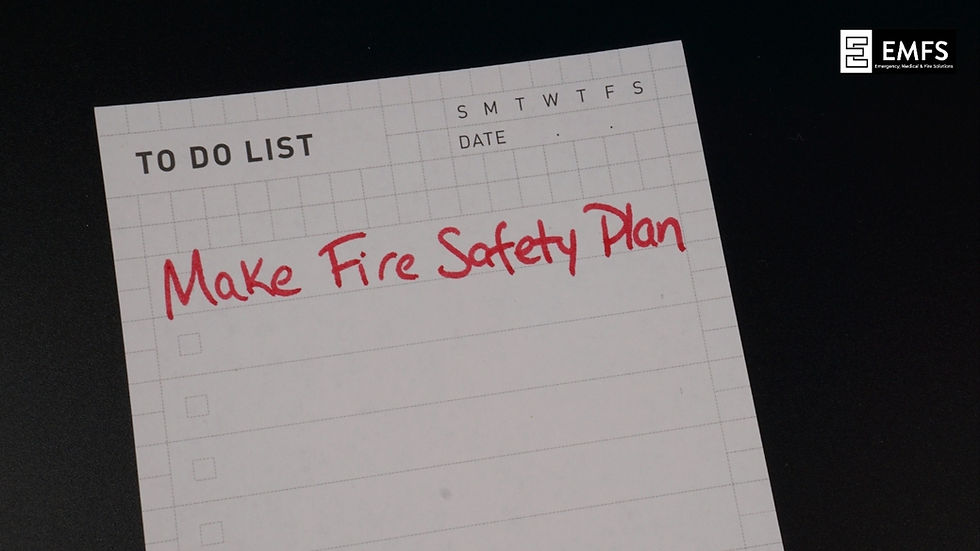E-Scooter and E-Bike Fire Hazards: What Owners Need to Know
- EMFS Group

- Jul 19, 2024
- 3 min read
Updated: Aug 20, 2024

With the increasing popularity of e-scooters and e-bikes as eco-friendly and convenient modes of transport, it's essential to be aware of the associated fire hazards and how to prevent them. As more people adopt these modern transportation methods, understanding the risks and safety precautions becomes crucial to ensure the safety of riders and those around them.

stats provided by: https://www.london-fire.gov.uk/
The Growing Threat: Real-Life Incidents and Statistics
While e-bikes and e-scooters offer a great way to navigate urban environments, if their batteries become damaged or begin to fail, they can start incredibly ferocious fires. Lithium battery fires can spread quickly out of control, and within seconds start a large fire. When these batteries are charged in communal areas or escape routes, a fire breaking out can quickly block people’s ability to escape.
On average, there was a fire every two days in 2023 in London. London Fire Brigade attended 143 e-bike fires along with 36 blazes involving e-scooters. Sadly, there were 3 deaths and around 60 injuries caused by these fires. Many of these fires are caused by incompatible chargers, modifications to e-bikes, or faulty or counterfeit products purchased online, including chargers, lithium batteries, and conversion kits for e-bikes.
Understanding the Hazards
Battery Malfunction: E-scooters and e-bikes are powered by lithium-ion batteries, which, while efficient, can pose significant fire risks if not properly managed. These batteries can overheat, short-circuit, or suffer damage, leading to fires.
Overcharging: Leaving an e-scooter or e-bike on charge for too long can cause the battery to overheat. Many e-scooter and e-bike fires are the result of overcharging, where the battery gets excessively hot and potentially ignites.
Physical Damage: Dropping or mishandling an e-scooter or e-bike can damage the battery, making it more susceptible to fires. Even small punctures or impacts can compromise battery integrity.
Poor Quality Components: Cheap or counterfeit batteries and chargers often lack the necessary safety features to prevent overheating and overcharging. Using non-certified components increases the risk of fire.

Safety Measures for E-Scooter and E-Bike Owners
Proper Charging Practices:
Always use the charger provided by the manufacturer.
Avoid overcharging by unplugging the charger once the battery is full.
Charge your e-scooter or e-bike in a safe area outside the home if possible, away from flammable materials.
Do not charge the e-scooter or e-bike overnight or when you are not at home.
Regular Inspections:
Check your e-scooter or e-bike for any signs of damage, especially the battery compartment.
Look for any swelling, leakage, or unusual smells from the battery area.
Ensure that all electrical connections are secure and free from corrosion.
Storage Tips:
Store your e-scooter or e-bike in a cool, dry place away from direct sunlight and heat sources.
Avoid exposing the e-scooter or e-bike to extreme temperatures, both hot and cold.
If storing for an extended period, ensure the battery is partially charged (around 50%) to maintain its health.
Quality Components:
Purchase e-scooters, e-bikes, batteries, and chargers from reputable manufacturers.
Ensure that any replacement parts are certified and meet safety standards.
Avoid using second-hand batteries or chargers unless they are from a trusted source and in good condition.
Safe Riding Practices:
Ride cautiously to avoid accidents that could damage the battery.
Avoid riding in severe weather conditions that could impact the e-scooter’s or e-bike’s electronics.
Regularly maintain your e-scooter or e-bike, checking for any signs of wear and tear that could lead to mechanical or electrical failures.

Emergency Preparedness
Fire Extinguishers:
Keep a fire extinguisher nearby when charging your e-scooter or e-bike. A Class D extinguisher is recommended for lithium-ion battery fires.
Evacuation Plan:
If you need to charge your scooter or bike indoors, have an evacuation plan in place in case of a fire. Ensure all household members know the exits and meeting points.
Familiarise yourself with the procedures for dealing with small fires, such as using a fire blanket or extinguisher.
Insurance:
Consider insuring your e-scooter or e-bike to cover potential damages from fires or accidents.
Conclusion: E-scooters and e-bikes are fantastic ways to navigate urban environments, offering both convenience and sustainability. However, with their rise in popularity, it's essential to be aware of the potential fire hazards and take proactive measures to mitigate these risks. By following the safety tips outlined above, e-scooter and e-bike owners can enjoy their rides while ensuring their safety and the safety of those around them.
Stay informed, stay safe, and enjoy your ride!



Comments